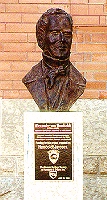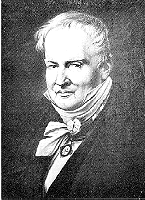

What about Humboldt, Saskatchewan? An unusual name in this part of the world. When the name was chosen there wasn't a permanent resident within miles, yet it was a very appropriate one for a community that was later to be settled largely by people of German orgin.
The name honors Baron Alexander von Humboldt, a prominent German scientist, born in Berlin on September 4, 1069. The two-hundredth anniversary of his birth went largely unnoticed in Canada but he was one of the great geniuses of all time.
Bertheloth, the French chemist , wrote, "This man is a whole academy in himself," and Goethe regarded him as a second Aristotle, and another (Leighly) referred to him as "the Prince of scientific travellers".
Von Humboldt was one of the most famous men in Europe in the first half of the 19th century. In fact, he was regarded next to Napoleon in importance.
Alexander von Humboldt was one of those rare scholars able to embrace most of the knowledge of this time. He contributed original work in such fields as geology, meteorology, physilogy, anthropology and geography.
He was one of the first men to effectively take science from the armchair and put it in the fields and in the laboratories.
Alexander von Humboldt started to make preparations for his long-dreamed of voyage to the strange, relatively unknown lands of South America. However, he was delayed by political circumstances and the Napleonic war, but used the period of waiting for careful preparations; studying the history of the people, old maps and reports in libraries.
In 1799, in Paris, he met Aime Bonpland, a medical doctor, who was manily interested in plants. The two set out from Paris through Marseilles to Madrid in order to go to South America.
In Madrid, they were unexpectedly fortunate to gain the patronage of Prime Minister Marino de Quijo who secured the support of the government to make Spanish America the scene of exploration. Humboldt and his friend were sent to areas where no scientists had been before.
He did not stop working until a few weeks before his death in his 90th year. The "Prince of Scientific Travels", as Leighly referred to him, gained more informatin on more subjects than any other scientific writer before and perhaps since.
On May 6, 1859, Alexander von Humboldt died in Berlin. After a life crowned with success, the world witnessed the passing of one of the greatest of all naturalists. In Berlin Cathedral the funeral service was attended by all the Court and State dignitaries, all the personalities eminent in art and science, and the entire university and simple workers alike. The following day, May 11, the coffin was taken to Tegel, where the body of Alexander von Humboldt was laid to rest beside that of his brother Wilhelm.

Excerpts from Humboldt On The Carlton Trail, 1975.
[ Home ]
Please send comments to Carlton Trail REDA Inc.
![]()
[ The Humboldt Journal ]
[Early Humboldt]
[ St. Peter's Abbey | Agriculture | Communities ]
[ Present-day Humboldt and Surrounding Communities ]
[ Language ]
![]()